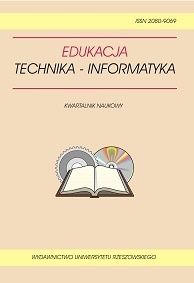Neurodidactic Aspects of the Process of Solving a Mathematical Test Task Based on the Eye-Tracking Research
Keywords:
neurodidactics, eye-tracking research, solving mathematical tasks, depth of information processingAbstract
Contemporarily the necessity of regarding the knowledge of brain structure and functions in the didactic processes is more and more frequently discussed. Neurodidactics, as a cross-disciplinary science is engaged in the learning and education process which is based on the results of research on brain functioning. One of the non-invasive methods that can provide us with knowledge on brain functioning is the research carried out with an eye-tracker, a device used for tracing eyeball movements of a tested person. This paper will present a part of the research in which the eye-tracking technology has been used. The aim of the presented research was an attempt to analyse the depth of information processing by a pupil during solving a mathematical test task. The research results point to certain characteristic pupils’ behaviour while making decision concerning the choice of an answer marked by them.Downloads
Published
2015-09-30
How to Cite
ROŻEK, B., BŁASIAK, W., ANDRZEJEWSKA, M., GODLEWSKA, M., KOZUBOWSKI, P., ROSIEK, R., SAJKA, M., STOLIŃSKA, A., & WCISŁO, D. (2015). Neurodidactic Aspects of the Process of Solving a Mathematical Test
Task Based on the Eye-Tracking Research. Journal of Education, Technology and Computer Science, 13(3), 202–208. Retrieved from https://journals.ur.edu.pl/jetacomps/article/view/6457
Issue
Section
VIDEO EDUCATION. CURRENT STATUS AND DEVELOPMENT PROSPECTS
License
Copyright (c) 2015 Journal of Education, Technology and Computer Science

This work is licensed under a Creative Commons Attribution-ShareAlike 4.0 International License.

